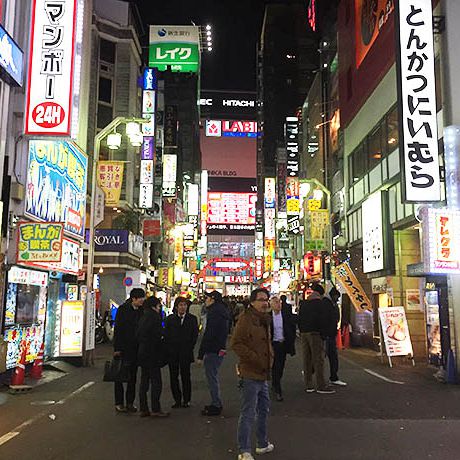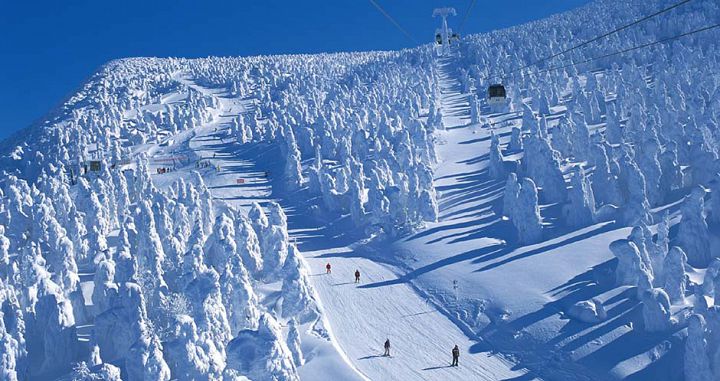Zao Onsen ski resort is a Scout favorite and a lesser-known gem. It has a charming, traditional village, a great selection of hotels, natural onsen hot springs and a vast ski resort featuring its famed snow monsters. If you’re looking to get away from all the Westerners, experience something rich in culture combined with some great skiing, then Zao Onsen makes a great choice.
Scout Loves
- The charming and traditional village.
- Plenty of onsen that are high in sulfur making it great for your skin.
- The famed snow monsters – or Juhyo.
- A wide range of accommodation from small, rustic ryokan inns to grand hotels.
- Zao Onsen is a beginner and intermediate skiers’ paradise. Lots of long cruisers and the chance to explore different areas.
Scout Tips
- Some of the slopes aren’t well connected.
- English isn’t widely spoken, though you can usually get by. The local tourist office at the bus station is very helpful.
- There are a few rental shops. Just don’t expect the highest quality equipment or the latest powder skis. If you have large feet you may want to rent boots from home and bring them with you.
- A good walk up hills to get to the ski slopes is required from some hotels and there is no public shuttle service.
- Ski lessons in English are only available through private lessons.
- There is only one bar in the village (at least, when we visited). Along with the countless vending machines serving beer, this might be your only option for any sort of après drinking.
Scout Review
Zao Onsen ski resort is a delight. While many resorts throughout Japan have adapted and changed to suit Western tastes and needs, Zao remains relatively untouched. Yet the lifts and infrastructure are decent and getting there and around is pretty simple. Sure there aren’t lots of high-speed quads, some of the ski slopes are poorly linked and you may encounter some difficulties with the lack of English – but all this adds to the charm.
Zao Onsen is located in Yamagata prefecture. The village of Zao Onsen is steeped in history. According to legend, the hot springs were discovered in the year AD110. Over the years Zao became popular for bathers who came to take advantage of the high sulfur in the onsen. The acidity of Zao’s hot springs is stronger than lemon juice (pH2.5) and therefore has great therapeutic effects. So much so that they’re often referred to as “Springs of beauty” and the “Springs of healthy children”. It also washes the town in a rather faint smell of rotten eggs thanks to the sulfur, which gets stronger the closer you are to a hot spring – though it’s not offensive for most people. There are several old wooden public onsen houses (with indoor and outdoor onsen) and some of the hotels boast beautiful onsen. If onsening is your thing, then Zao makes a particularly great choice!
Zao is also one of Japan’s oldest ski resorts and today it’s one of the more popular resorts for Japanese who love to do the ski and onsen combo. It’s also well known for its snow monsters or Juhyo. The local tourist brochure proudly boasts that “it would not be an exaggeration to call the mountain a “Natural World Heritage Site of Winter”. They’re not far off, and while snow monsters can be seen at other Japanese ski resorts (most notably at Shiga Kogen and Hakkoda), Zao probably has the best. The Juhyo form when dry-season freezing winds from Siberia take on moisture over the Sea of Japan. When these winds collide with the Maries’ fir trees on the top of the mountain and freeze, it creates large monster-like sculptures. They are best in January and February and can be viewed by taking the top ropeway. Sadly it’s frowned upon to ski amongst them (though some do). The snow monsters are illuminated at night for most of February and weekends in January.
The village of Zao Onsen is wonderful for meandering. There are some great restaurants, souvenir shops and cultural landmarks. The layout is quite spread out and hilly and it’s pretty much divided into two areas by two rivers. The left side of the village extends up from the bus terminal and is where you will find most of the cute shops, restaurants, onsen and more traditional hotels. The right side, near the two ropeways, is dominated by modern Japanese hotels which are more convenient to the ski slopes.
Zao Onsen Skiing
Covering 300ha/741acres and with 42 lifts, Zao Onsen ski resort is one of the larger ski resorts in Japan. It also boasts a 10km-long ski run! It’s quite spread out over different ridges so takes several days to explore properly.
Like many other ski resorts in Japan, it’s actually made up of a variety of ski areas owned by different companies – in Zao’s case it’s nine. What this means is that some of the areas aren’t particularly well connected and will often require a fair bit of shuffling, skating and poling to get between – not ideal for snowboarders. Although there are signs in English it can also be quite tricky to navigate between the different areas.
This is our only real beef about Zao and, other than that, it will satisfy all standards of skiers for at least a few days.
The slopes aren’t particularly great for advanced skiers but there are opportunities for decent off-piste skiing. Skiing in the trees (except for the snow monsters and lift lines) is generally tolerated, yet not popular. This means it doesn’t get tracked out quickly so powderhounds will have a ball, particularly after a weekday storm. Zao’s steepest slope is the 38 degree Yokokura Wall run, but it’s pretty short so won’t keep advanced skiers and boarders entertained for long. The other place that will challenge advanced skiers is the Hahnenkamm Course, appropriately named after the famous ski race in Kitzbuhel, Zao’s sister resort in Austria.
There are plenty of good wide-open green slopes for beginners, though some in the Nakamori base area may be a little daunting for first timers. There are lots of flat runs up in the Chuo and Diamond areas.
It’s the intermediates that will have the most fun at Zao Onsen thanks to the many different areas to discover, lots of long, well-groomed and moderately steep runs, mogul fields and cable cars and ropeways accessing most of it. Scout particularly liked the Kurohime Slope on the looker’s far right side of the mountain.
Zao has a few terrain park features and snowboard parks on the Nakamori and Chuo slopes. There is night skiing on the Uwanodai and Yokokura slopes.
Like many Japanese resorts there’s a multitude of lift tickets available, including those operating on points, others operating on hours and then regular day and multi-day tickets.
Zao Onsen For Families
Zao Onsen would make a good choice for more adventurous families wanting to experience an authentic Japanese ski holiday. Kids will love the snow monsters and dressing up in yukata kimono for dinner. It may be a bit of a struggle for those with young children whose gear you need to carry to the slopes, since the hotels are quite spread out and there is no shuttle. Chose a hotel close to the ropeways if this is your situation.
There is a ski school that has English-speaking instructors, for private lessons only. If your kids need lessons there are probably better resorts to choose from.
Zao Onsen Accommodation
Search Hotelsand Deals >
There is a wide variety of accommodation in Zao Onsen. From basic pensions to luxurious ryokans and deluxe Japanese/Western style hotels, almost all tastes are well catered for. However, there are no self-catered options or Western-run hotels. Those on the right side of the village are newer hotels with the easiest access to the slopes via the two ropeways. More traditional hotels, pensions and ryokans are found in the heart of the old village on the left side, extending up from the bus terminal. These have a slightly more difficult access to the ski slopes since the base of the Zao Sky Cable is up a fairly steep hill. The walk to the ropeways is flatter and easier and takes about 10-15 minutes. Some hotels do provide lifts to the ropeways, but mostly you are left to your own devices for getting to the slopes, which means walking since there is no skiers shuttle.
Most hotels only offer full-board options, including breakfast and dinner. Some have fairly limited Western food options. Almost all of the hotels in Zao Onsen also have onsen - some are better than others.
Depending on your criteria, you’ll want to choose your lodging in Zao Onsen carefully to make sure it’ll suit your desires. Read our detailed reviews to find the right one for you and once chosen (or if you need help choosing) contact Scout to help with your Zao Onsen booking.
Search Hotels and DealsResort Activities
Get yourScout Field Guide >
The main attraction of Zao Onsen, apart from the skiing, the snow monsters and the onsen, is the charm of the village. There are few other activities. You can take guided snowshoe tours of various snowfields (including the monsters), there is a Fire and Ice festival at the end of January and that’s about it.
If you’re there with young kids or have kids at home be sure to visit one of the stores selling traditional kokeshi dolls. These wooden figurines are traditional to the region and you can find a wide variety from cheap souvenirs to antique collector’s items.
Day trips to Yamagata City are easy to do and it’s famous for being a castle town with many old temples, ruins and castles, particularly those in Kajo Park.
Getting There and Around
Zao Onsen is relatively easy to get to. The easiest and most common way to get there from Tokyo is a three-hour Shinkansen (Bullet Train) ride to Yamagata. From the station it’s easy to catch a public bus (once you locate the bus stop!) all the way to the resort. It takes 40 minutes and has hourly departures until 10pm. An alternative is to catch the Shinkansen to Sendai station, and although this is a faster train journey, it has a longer bus ride (1hr, 40mins) on to Zao Onsen, making it almost the same length of time as the Yamagata route.
The fastest option is to fly from Narita to Sendai airport, and from there catch the bus.
To get around Zao Onsen village you are pretty much limited to your own two feet. However, it’s fairly compact and easy to get around apart from the steepness of the hills on the upper left-hand side. It’s great for wandering, particularly throughout the little streets and alleyways in the older part.
When To Go
Zao Onsen has a long season, extending from late November until May. The best time to see the snow monsters is late January and February, which is also a good time to get the best powder. Zao Onsen does get the occasional bit of unpleasant weather featuring frozen rain and howling winds, which is what helps the monsters form.
Facts & Figures
| Mountain Information | Lifts | Terrain | ||||
| Base Elevation | 2559ft / 780m | Gondolas | 1 | Beginner | 40% | |
| Summit Elevation | 5449ft / 1661m | Ropeways | 3 | Intermediates | 40% | |
| Vertical Drop | 2890ft / 881m | Express Quad | 1 | Advanced | 20% | |
| Skiable Area | 459.6ac / 185.9ha | Quad Chairs | 4 | |||
| Annual Snowfall | 472.4in / 12m | Triple Chairs | 3 | |||
| Longest Run | 2.48 miles / 4km | Double Chairs | 28 | |||
| Operating Hours | 8.30am – 9.00pm | Single Chairs | 1 |

Tokyo's Top 5 Districts to Eat, Stay, & Play.
Check out Scout's list of our top Tokyo hotspots (and why we love them!) read more

Staying in a Japanese Hotel
It’s a wonderful treat to stay in a hotel that offers a glimpse into Japanese culture. Read Scout's guide to what to expect ... read more

Guide to Skiing in Japan
Scout's introduction to skiing in Japan with an overview of what it's like to ski in Japan as well as some insider tips. read more
Dream
Stories, photos and ski resort profiles to help you discover new places and dream about your next ski trip.
Find
Independent and detailed reviews of ski resorts and accommodation to help you find what's right.
Book
Expert advice & competitive rates. From hotel rooms to full ski packages, our agents will find you the best deals.
Ski
Time to go skiing! Get all the inside-tips for your resort in your Scout Field Guide. Free for bookings at major resorts.















Subscribe to the Scout newsletter - a regular roundup of news from the slopes and magazine articles.